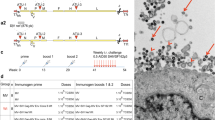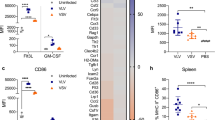Abstract
We pseudotyped HIV-1 vectors with cytoplasmic tail-truncated envelope glycoproteins of a wild-type (WT) measles virus (MV). The particles entered the lymphatic cells exclusively through the signaling lymphocyte activation molecule (SLAM, CD150), whereas particles pseudotyped with the MV vaccine strain glycoproteins also recognized the ubiquitous membrane cofactor protein (CD46) as receptor and had less specific cell entry. MVWT-HIV vectors reached titers of 108 t.u. ml−1, which were up to 10-fold higher than those of MVVac-HIV vectors, and discriminated between SLAM-positive and SLAM-negative cells, also in mixed cell cultures. As these vectors transduce primary human cells more efficiently than vesicular stomatitis virus-G pseudotyped vectors do, they are promising candidates for gene transfer to human lymphocytes and certain epithelial cells.
This is a preview of subscription content, access via your institution
Access options
Subscribe to this journal
Receive 12 print issues and online access
$259.00 per year
only $21.58 per issue
Buy this article
- Purchase on Springer Link
- Instant access to full article PDF
Prices may be subject to local taxes which are calculated during checkout



Similar content being viewed by others
References
Cronin J, Zhang XY, Reiser J . Altering the tropism of lentiviral vectors through pseudotyping. Curr Gene Ther 2005; 5: 387–398.
Sandrin V, Russell SJ, Cosset FL . Targeting retroviral and lentiviral vectors. Curr Top Microbiol Immunol 2003; 281: 137–178.
Cockrell AS, Kafri T . Gene delivery by lentivirus vectors. Mol Biotechnol 2007; 36: 184–204.
Funke S, Maisner A, Muhlebach MD, Koehl U, Grez M, Cattaneo R et al. Targeted cell entry of lentiviral vectors. Mol Ther 2008; 16: 1427–1436.
Frecha C, Costa C, Negre D, Gauthier E, Russell SJ, Cosset FL et al. Stable transduction of quiescent T-cells without induction of cycle progression by a novel lentiviral vector pseudotyped with measles virus glycoproteins. Blood 2008; 112: 4843–4852.
Vongpunsawad S, Oezgun N, Braun W, Cattaneo R . Selectively receptor-blind measles viruses: identification of residues necessary for SLAM- or CD46-induced fusion and their localization on a new hemagglutinin structural model. J Virol 2004; 78: 302–313.
Leonard VH, Sinn PL, Hodge G, Miest T, Devaux P, Oezguen N et al. Measles virus blind to its epithelial cell receptor remains virulent in rhesus monkeys but cannot cross the airway epithelium and is not shed. J Clin Invest 2008; 118: 2448–2458.
Yanagi Y, Takeda M, Ohno S . Measles virus: cellular receptors, tropism and pathogenesis. J Gen Virol 2006; 87 (Part 10): 2767–2779.
Condack C, Grivel JC, Devaux P, Margolis L, Cattaneo R . Measles virus vaccine attenuation: suboptimal infection of lymphatic tissue and tropism alteration. J Infect Dis 2007; 196: 541–549.
Veillette A . Immune regulation by SLAM family receptors and SAP-related adaptors. Nat Rev Immunol 2006; 6: 56–66.
Tahara M, Takeda M, Shirogane Y, Hashiguchi T, Ohno S, Yanagi Y . Measles virus infects both polarized epithelial and immune cells by using distinctive receptor-binding sites on its hemagglutinin. J Virol 2008; 82: 4630–4637.
Takeda M, Tahara M, Hashiguchi T, Sato TA, Jinnouchi F, Ueki S et al. A human lung carcinoma cell line supports efficient measles virus growth and syncytium formation via a SLAM- and CD46-independent mechanism. J Virol 2007; 81: 12091–12096.
Takeda M, Takeuchi K, Miyajima N, Kobune F, Ami Y, Nagata N et al. Recovery of pathogenic measles virus from cloned cDNA. J Virol 2000; 74: 6643–6647.
Singh M, Cattaneo R, Billeter MA . A recombinant measles virus expressing hepatitis B virus surface antigen induces humoral immune responses in genetically modified mice. J Virol 1999; 73: 4823–4828.
Liebert UG, Flanagan SG, Loffler S, Baczko K, ter Meulen V, Rima BK . Antigenic determinants of measles virus hemagglutinin associated with neurovirulence. J Virol 1994; 68: 1486–1493.
Tiscornia G, Singer O, Verma IM . Production and purification of lentiviral vectors. Nat Protoc 2006; 1: 241–245.
Clavel F, Charneau P . Fusion from without directed by human immunodeficiency virus particles. J Virol 1994; 68: 1179–1185.
Cathomen T, Naim HY, Cattaneo R . Measles viruses with altered envelope protein cytoplasmic tails gain cell fusion competence. J Virol 1998; 72: 1224–1234.
Tatsuo H, Ono N, Tanaka K, Yanagi Y . SLAM (CDw150) is a cellular receptor for measles virus. Nature 2000; 406: 893–897.
Buchholz CJ, Schneider U, Devaux P, Gerlier D, Cattaneo R . Cell entry by measles virus: long hybrid receptors uncouple binding from membrane fusion. J Virol 1996; 70: 3716–3723.
Takeuchi K, Miyajima N, Nagata N, Takeda M, Tashiro M . Wild-type measles virus induces large syncytium formation in primary human small airway epithelial cells by a SLAM(CD150)-independent mechanism. Virus Res 2003; 94: 11–16.
Navaratnarajah CK, Vongpunsawad S, Oezguen N, Stehle T, Braun W, Hashiguchi T et al. Dynamic interaction of the measles virus hemagglutinin with its receptor signaling lymphocytic activation molecule (SLAM, CD150). J Biol Chem 2008; 283: 11763–11771.
Schneider-Schaulies S, Schneider-Schaulies J, Niewiesk S, Ter Meulen V . Measles virus: immunomodulation and cell tropism as pathogenicity determinants. Med Microbiol Immunol 2002; 191: 83–87.
Welstead GG, Hsu EC, Iorio C, Bolotin S, Richardson CD . Mechanism of CD150 (SLAM) down regulation from the host cell surface by measles virus hemagglutinin protein. J Virol 2004; 78: 9666–9674.
Overbaugh J, Miller AD, Eiden MV . Receptors and entry cofactors for retroviruses include single and multiple transmembrane-spanning proteins as well as newly described glycophosphatidylinositol-anchored and secreted proteins. Microbiol Mol Biol Rev 2001; 65: 371–389, table.
Acknowledgements
This work was supported by grant BU 1301/2-1 of the priority Program ‘Mechanisms of gene vector entry and persistence’ of the Deutsche Forschungsgemeinschaft to CJB and KC. SF was supported by the graduate study program ‘GK1172 Biologicals’ of the Goethe University Frankfurt a.M. We thank Julia Brynza for excellent technical assistance and wish to acknowledge V Leonard (Mayo Clinic, USA) and Y Yanagi (Kyushu University, Japan) for the F and H expression plasmids and CHO-SLAM cells, respectively, and J Schneider-Schaulies (University of Würzburg, Germany) for the K83 hybridoma cell line.
Author information
Authors and Affiliations
Corresponding author
Rights and permissions
About this article
Cite this article
Funke, S., Schneider, I., Glaser, S. et al. Pseudotyping lentiviral vectors with the wild-type measles virus glycoproteins improves titer and selectivity. Gene Ther 16, 700–705 (2009). https://doi.org/10.1038/gt.2009.11
Received:
Revised:
Accepted:
Published:
Issue Date:
DOI: https://doi.org/10.1038/gt.2009.11
Keywords
This article is cited by
-
A scalable method to concentrate lentiviral vectors pseudotyped with measles virus glycoproteins
Gene Therapy (2015)
-
Specific Retrograde Transduction of Spinal Motor Neurons Using Lentiviral Vectors Targeted to Presynaptic NMJ Receptors
Molecular Therapy (2014)
-
Vectofusin-1, a New Viral Entry Enhancer, Strongly Promotes Lentiviral Transduction of Human Hematopoietic Stem Cells
Molecular Therapy - Nucleic Acids (2013)
-
Engineering a serum-resistant and thermostable vesicular stomatitis virus G glycoprotein for pseudotyping retroviral and lentiviral vectors
Gene Therapy (2013)
-
Targeted lentiviral vectors pseudotyped with the Tupaia paramyxovirus glycoproteins
Gene Therapy (2013)



